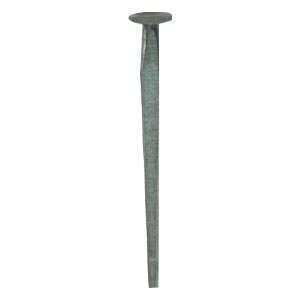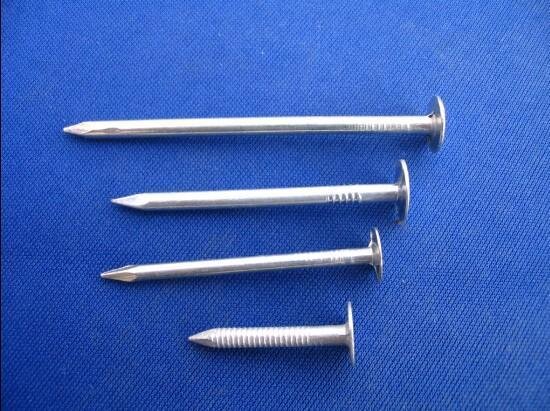1. (Modern) Any nail with a large flat head and a relatively thin shank, such as a roofing nail.

2. (Obsolete) Synonym for clinch nail.

While both Clout Nail and Clinch Nail are synonymous, the term "clinch" nail describes what it does. Historically, a theatrical "Flat" was built of what we now call dimension lumber. The lumber, commonly 1x3 or 1x4, was joined edge to end to form "flat" frames from 3/4" to 1" front to back. In the beginning the lumber was joined using traditional cabinet making techniques such as mortice and tenon, tenon and shoe, et. al. In the second quarter of the 20th century, manufactured lumber, i.e. plywood among others, was developed and became widely available and affordable. During the same period the time available to produce a show shrank while the expertise of the builders, especially in the great growth of regional and project theatres, also shrank. Scenery was now built by actors, teachers, students and fledgling technicians rather than experienced master craftsmen. Other methods of jointry were needed. One such method was the development of the flat butt joint and a plywood gusset. The gusset became known as the corner block.
The corner block was fastened across the butt joint to secure it and reenforce the joint. The method to fasten the corner block, quickly and securely was by nails, screws or by nails and glue or screws and glue. Nails alone were not strong enough and quickly pulled out with handling of the flat. Screws alone were better but far more time consuming and still not able to endure rough handling of touring or long run shows. Their plus was 100% material salvage for cash strapped groups. Adding glue to the mix made very sturdy units but added time and other problems as polyvinyl glue did not exist. Dry animal glue had to be mixed and cooked. One very good solution was to use nails longer than the thickness of the boards and bend them over (clinching) on the other side to prevent pulling out. Flipping the flat frame to bend over the nails was impractical as it usually pulled the joints apart. To clinch the nails a clinch plate (1/4" steel plate about 12"x12" was inserted under the flat. The nail was driven at a slight angle through the corner block, the lumber and then, hitting the plate, was bent over and back into the lumber, clinching the nail.
A true clout nail was made of a low carbon, soft alloy to facilitate the bending and clinching action. It was also retangular in section rather than round or wire shaped. The tip was square and blunt rather than sharp or pointed. The design was intended to "punch" through the wood rather than wedging between the grain. The punch action reduced or eliminated splitting of the wood, especially when driven across the wood grain.

2. (Obsolete) Synonym for clinch nail.

While both Clout Nail and Clinch Nail are synonymous, the term "clinch" nail describes what it does. Historically, a theatrical "Flat" was built of what we now call dimension lumber. The lumber, commonly 1x3 or 1x4, was joined edge to end to form "flat" frames from 3/4" to 1" front to back. In the beginning the lumber was joined using traditional cabinet making techniques such as mortice and tenon, tenon and shoe, et. al. In the second quarter of the 20th century, manufactured lumber, i.e. plywood among others, was developed and became widely available and affordable. During the same period the time available to produce a show shrank while the expertise of the builders, especially in the great growth of regional and project theatres, also shrank. Scenery was now built by actors, teachers, students and fledgling technicians rather than experienced master craftsmen. Other methods of jointry were needed. One such method was the development of the flat butt joint and a plywood gusset. The gusset became known as the corner block.
The corner block was fastened across the butt joint to secure it and reenforce the joint. The method to fasten the corner block, quickly and securely was by nails, screws or by nails and glue or screws and glue. Nails alone were not strong enough and quickly pulled out with handling of the flat. Screws alone were better but far more time consuming and still not able to endure rough handling of touring or long run shows. Their plus was 100% material salvage for cash strapped groups. Adding glue to the mix made very sturdy units but added time and other problems as polyvinyl glue did not exist. Dry animal glue had to be mixed and cooked. One very good solution was to use nails longer than the thickness of the boards and bend them over (clinching) on the other side to prevent pulling out. Flipping the flat frame to bend over the nails was impractical as it usually pulled the joints apart. To clinch the nails a clinch plate (1/4" steel plate about 12"x12" was inserted under the flat. The nail was driven at a slight angle through the corner block, the lumber and then, hitting the plate, was bent over and back into the lumber, clinching the nail.
A true clout nail was made of a low carbon, soft alloy to facilitate the bending and clinching action. It was also retangular in section rather than round or wire shaped. The tip was square and blunt rather than sharp or pointed. The design was intended to "punch" through the wood rather than wedging between the grain. The punch action reduced or eliminated splitting of the wood, especially when driven across the wood grain.




